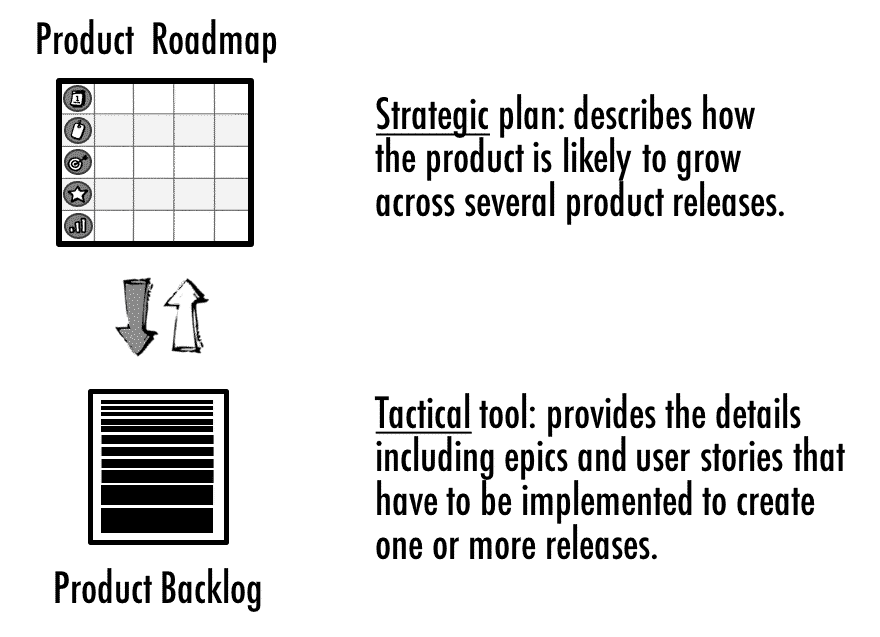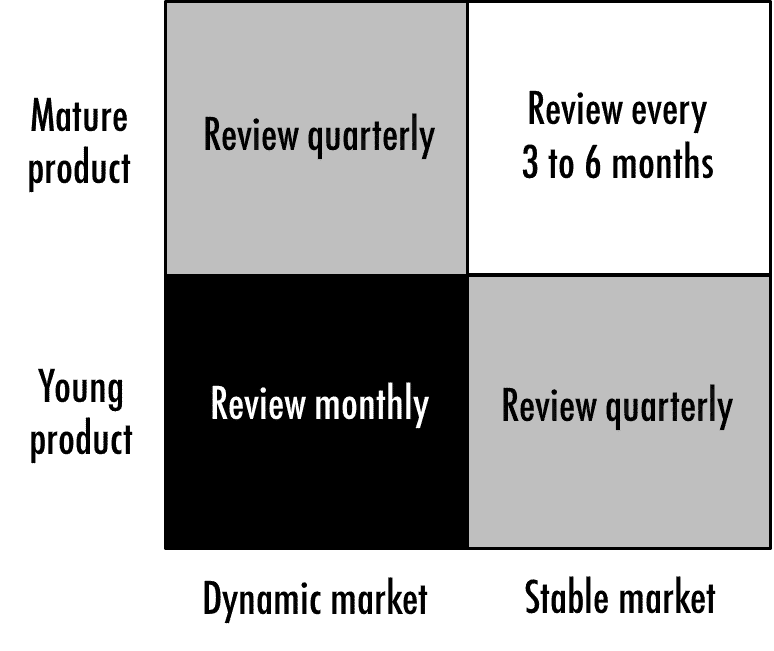1 Focus on Goals and Benefits
Whenever you are faced with an agile, dynamic environment—be it that your product is young and is experiencing significant change or that the market is dynamic with new competitors or technologies introducing change, you should work with a goal-oriented product roadmap, sometimes also referred to as theme-based. Goal-oriented roadmaps focus on goals or objectives like acquiring customers, increasing engagement, and removing technical debt. Features still exist, but they are viewed as second-class citizens; they are derived from the goals and used sparingly.
To help you develop your agile product roadmap, I have created a goal-oriented roadmap template called the GO Product Roadmap. It is built on the idea that goals are more important than features, and it consists of five elements: date, name, goal, features, and metrics, as the picture below shows. You can download the template for free from romanpichler.com/tools, and you can find more information on how to use it in my post The GO Product Roadmap.

2 Do the Necessary Prep Work
Describe and validate the product strategy—the path to realise your vision—before you create your roadmap and decide how the strategy is best implemented, as the following picture illustrates.

I like to use my Product Vision Board to develop a valid product strategy. The board captures the vision, the target group, the problem to be solved or the benefit to be provided, the key features of the product, and the business goals. You can download the Product Vision Board template from romanpichler.com/tools/ for free.
3 Tell a Coherent Story
Your product roadmap should tell a coherent story about the likely growth of your product. Each release should build on the previous one and move you closer towards your vision. Be clear who your audience is: An internal product roadmap talks to development, marketing, sales, service, and the other groups involved in making your product a success; and external roadmap is aimed at existing and prospective customers. Keep your roadmap realistic: Don’t speculate and don’t oversell your product.
4 Keep it Simple
Resist the temptation of adding too many details to your roadmap. Keep your roadmap simple and easy to understand. Capture what really matters and leave out the rest by focusing on the goals. Keep the features on your roadmap coarse-grained and derive them from the goals. The details, including the epics, user stories, scenarios and UI designs, belong in the product backlog and not on your roadmap, as the picture below shows.

5 Secure Strong Buy-in
The best roadmap is worthless if the people required to develop, market, and sell the product don’t buy into it. The best way to create agreement is to collaborate with the key stakeholders to create and update the product roadmap. This allows you to leverage their ideas and knowledge and creates strong buy-in. Running a collaborative roadmapping workshop is a great way to engage everyone and create a shared product roadmap, as the following picture illustrates.

6 Have the Courage to Say No
While you want to get buy-in to from the key stakeholders, you should not say yes to every idea and request. This would turn your product roadmap into a feature soup, a random collection of features. “Innovation is not about saying yes to everything. It’s about saying no to all but the most crucial features,” said Steve Jobs. Use your vision and product strategy to make the right decisions. Have the courage to say “no”. Remember: Collaboration requires leadership.
7 Know When to Show Dates
Some people recommend to never show dates on a product roadmap, others always include them. I recommend to use dates or timeframe on an internal roadmap that coordinates the work carried out by the internal stakeholders, such as, the development team, marketing, sales, and support. This is particularly important for date-driven products like smartphones that must be ready for Christmas sales or a travel app that has to be updated before the summer holidays start. But when you use an external roadmap that is shown to customers and users and often used as a sales tool, then I recommend not showing any dates or timeframes but sequencing your releases and possible employing a now-next-later grid to order them.
8 Make your Roadmap Measurable
When using a goal-oriented roadmap, ensure that every goal is measurable. This allows you to tell if you have met the goal or not. If your goal is to acquire customers, for example, then ask yourself how many new customers should be acquired; or if your goal is to reduce technical debt, determine how much of the bad code should be removed or rewritten.
If you don’t state a target, it will be hard to tell if you have met the goal or not. Make sure, though, that you state a realistic target, and that the goals on your roadmap are realistic. Then select the metrics that will help you determine if a goal has been met and if a release has delivered the desired benefit.
9 Determine Cost Top-Down
Whenever your product is new, young, or changing, I recommend that you do not attempt to determine the development cost bottom-up but rather top-down. It’s virtually impossible to derive the right epics and user stories from the roadmap features, get correct estimates from your team, and accurately anticipate the velocity and the rate of change in the product backlog. Even if you manage to make it work, you will end up with an overly long and complex product backlog that is difficult to adjust and maintain. What’s more, it can take days—and in some cases weeks—to turn the features into well-defined requirements and to come up with detailed estimates.
Instead, determine how many people with which skills are likely to be required to create the desired releases on the roadmap. Draw on your experience of developing similar products or previous versions of the same product; consider whether enough people with the right expertise are available in your company, or if you will have to hire or contract people. This should give you an indication of the likely labor cost required. Then add the cost for facilities, infrastructure, materials, licenses, and other relevant items. Carry out this exercise together with the development team.

10 Regularly Review and Adjust the Roadmap
Last but not least: If the environment you’re in is agile, then change is likely to occur. You should therefore regularly review and update your product roadmap—between every four weeks to every three months depending on how young your product and how dynamic the market is.

Learn More
You can learn more about agile product roadmaps by: